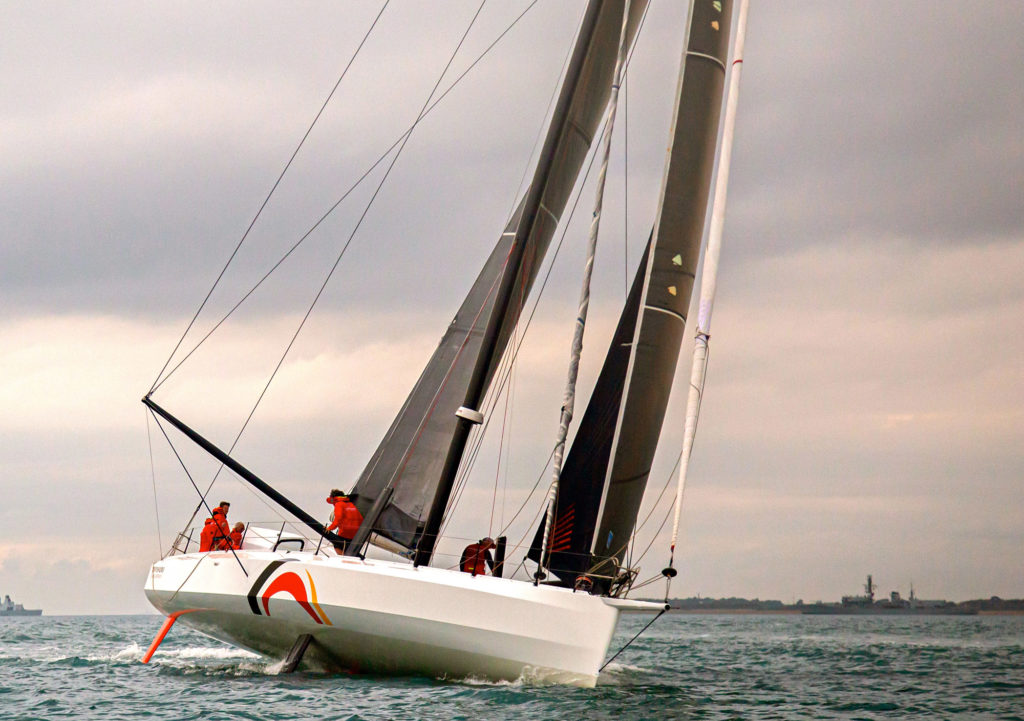DIE FORMEL 1 DER WELTMEERE

Technische Entwicklung
Im Jahr 1998 wurden schwenkbare Kiele zur Norm, um ein höheres Aufrichtendes Moment zu erzeugen. Computersysteme sind immer wichtiger, um den Skippern im Abrufen der Wettervorhersagen zu helfen und mit dem Land zu kommunizieren. Autopiloten sind immer intelligenter und selbstlernend geworden. Rümpfe und Segelpläne änderten sich im Laufe der Zeit, wobei die Boote mit breiteren Hecks höheres Potential zeigten und gleichzeitig eine verbesserte Leistung auf Kreuzkursen erzielten.
Auch die Cockpits wurden sicherer. Lange Coachroofs mit Schiebedächern schützen die Segler bei hohen Geschwindigkeiten und stürmischen Bedingungen. Seit 2015 werden Hydrofoils in die Boote eingebaut. Durch den reduzierten Strömungswiderstand beim Foilen erreichen die Boote noch höhere Geschwindigkeiten. Um die immensen Entwicklungskosten etwas zu kontrollieren, müssen Neubauten seit 2013 einen Einheitsmast und -Kiel fahren.
Die Sicherheitsanforderungen an die Designer und Segler haben viel zum Erfolg der Bootsklasse beigetragen. Um bei einem Rennen antreten zu dürfen, müssen die Boote z. B. unter Beweis stellen, dass sie bei einer schweren Kenterung wasserdicht und absolut schwimmfähig sind und sich ohne fremde Hilfe selbst aufrichten können. Die Klassenregeln schreiben ein unsinkbares Design vor.
Die Boote müssen über lange Zeiträume völlig autark und in schwierigen bis sehr schwierigen Gewässern in der Lage sein, starken Stürmen standzuhalten und Notfälle ohne die Erwartung von externer Hilfe zu bewältigen.

Technische Daten
Länge: Maximum 18,28 m
Breite: Maximum 5,85 m
Tiefgang: Maximum 4,5 m
Masthöhe: Maximum 29 m
Verdrängung: zwischen 8 – 9 t
Segelfläche am Wind: 330 m²
Segelfläche vorm Wind: 620 m²
Kiel-Typ: Swing (canting)
Acciona
Die ESP 8 wurde vom ehemaligen spanischen Rennstall „Acciona“ für die Vendée Globe 2012/13 gebaut. Das Owen/Clarke-Design machte durch wirklich schnelle Passagen auf sich aufmerksam, segelte größtenteils jedoch unter seinem Potential und schied durch eine Kenterung auf dem Rückweg im Atlantik aus dem Rennen aus. Ein sportlich gescheitertes Projekt, mit den bis dato höchsten R&D-Kosten der Szene.
Blockiert durch einen Versicherungsstreit konnte das Schiff bis heute nicht in den Rennzirkus zurückkehren.
Anfang 2017 erwirbt OTG „Acciona“ mit der Philosophie, ein komplett neues Schiff um den bewährten Rumpf zu bauen. Der gesamte Refit teilt sich in zwei Etappen.
Für die umfangreichen Composite-Reparaturen und -Modifikation wurde die Werft Trimarine in Lissabon/Portugal unter der Leitung von Fernando Sena beauftragt.
Charles Euverte übergibt Ende 2018 das durchplante Projekt an Joff Brown, der nun für den kompletten Neuausbau der Yacht mit Kiel, Mast, Elektrik, Elektronik und Rigging in Gosport/Südengland verantwortlich zeichnet.
Geplanter Termin für die Seatrials ist im Mai 2019.
Nach sieben Jahren Winterschlaf wird das Schiff vorerst auf konventionellen Straightboards zurückkehren, bevor es mit einer zweiten Refit-Phase ein technologisches Jahrzehnt ins Foil-Zeitalter überspringt.
